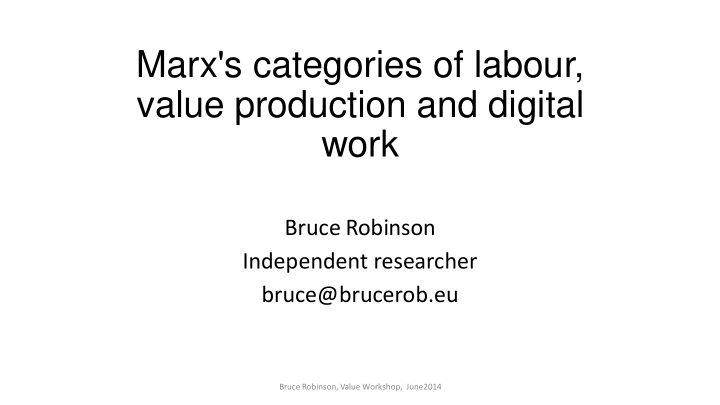



Marx's categories of labour, value production and digital work Bruce Robinson Independent researcher bruce@brucerob.eu Bruce Robinson, Value Workshop, June2014
INTRODUCTION • Digital labour is heterogenous in terms of social and economic relations and value production • Includes direct waged production, products of labour appropriated, autonomous, free labour and non-human automated labour • Marx’s categories of labour enable us to identify value - producing forms and make useful distinctions • …and also to critique existing theories Bruce Robinson, Value Workshop, June 2014
MARX’S CATEGORIES OF LABOUR • Abstract and concrete labour • Subsumed and non-subsumed labour • Productive and unproductive labour • Waged and unpaid labour • Living and dead labour Bruce Robinson, Value Workshop, June2014
ABSTRACT AND CONCRETE LABOUR • Social relations not concrete content determine whether labour is productive of value “...the designation of labour as productive labour has absolutely nothing to do with the determinate content of the labour, its special utility, or the particular use-value in which it manifests itself. The same kind of labour may be productive or unproductive .” • Marx not just a theorist of industrial labour • Abstract labour not a direct measure of labour time • Labour time as regulator of production Bruce Robinson, Value Workshop, June2014
SUBSUMED AND AUTONOMOUS LABOUR • A directly subordinate relationship to capital contributing to valorisation of capital • Capitalist has power to: (real subsumption) 1. Control the labour process – goal, organisation, methods, authority 2. Dispose of the product 3. Control the worker’s labour time quantitatively (how much and when worked) and qualitatively (what is done) • Digital work • Traditional waged work – 1,2,3 • Facebook / Google use – neither 1 nor 3 (with minor qualifications) nor 2 for Google • Prosumer / crowdsourcing – 1 varies, 2 applies, 3 doesn’t Bruce Robinson, Value Workshop, June2014
MILTON AND PUPL • “Milton, who wrote Paradise Lost for five pounds, was an unproductive labourer. On the other hand, the writer who turns out stuff for his publisher in factory style, is a productive labourer. Milton produced Paradise Lost for the same reason that a silk worm produces silk. It was an activity of his nature. Later he sold the product for £5 and thus became a merchant. But the literary proletarian of Leipzig, who fabricates books... under the direction of his publisher, is a productive labourer; for his product is from the outset subsumed under capital, and comes into being only for the purpose of increasing that capital.” Bruce Robinson, Value Workshop, June2014
PRODUCTIVE AND UNPRODUCTIVE LABOUR • Two aspects: social relation to capital and function within the accumulation process • Non-subsumed: outside accumulation process • Unproductive functions: circulation • Productive labour produces surplus value but… • …in circuit M -C-P- C’ - M’ only P creates value • Capital has an interest in reducing costs of necessary but unproductive functions – circulation, reproduction, state expenditure Bruce Robinson, Value Workshop, June2014
COMMERCIAL CAPITAL & ADVERTISING • Specialisation of function C’ - M’ in commercial capital • Specialisation within commercial capital does not affect share of capital or overall function • Transfer not creation of value • Advertiser’s motivation is realisation of value at lowest cost (of circulation) • “The costs which we are considering here are those of buying and selling. We have already noted earlier that these resolve themselves into accounting, book-keeping, marketing, correspondence, etc... All these costs are not incurred in producing the commodities' use-value, but rather in realising their value. They are pure costs of circulation.” Bruce Robinson, Value Workshop, June2014
WAGED AND UNWAGED LABOUR • Unpaid digital labour productive of value has grown – e.g. crowdsourcing, ‘traditional’ prosumer • Subsumed goal and disposal of the product but no guarantee of labour input • Appropriation enforced by surrender of property rights not wage discipline cf primitive accumulation • Unpaid labour cannot define class location Bruce Robinson, Value Workshop, June2014
CRITIQUE OF FUCHS-SMYTHE • Web 2.0 as platforms for advertising mediating between users and advertisers • Directly dependent on non-Web 2.0 capital • User presence as consumer of advertising necessary but… • User labour autonomous • User data used to cut costs of circulation.. • ..and not a product of human labour • Users can leave Bruce Robinson, Value Workshop, June2014
SOME DISTINCTIONS IN DIGITAL LABOUR • Prosumers working on pre-defined projects and Web 2.0 users • Autonomous labour vs petty production vs waged labour • Petty producers vs outsourced workers • Directly employed workers e.g.by Google and Web 2.0 users Bruce Robinson, Value Workshop, June2014
CONCLUSIONS • Need for differentiated understanding of forms of digital work in relation to value production • Distinctions draw on relation to capital, functional differences in the circuit of capital • Key issue of subsumption Bruce Robinson, Value Workshop, June2014
Bruce Robinson, Value Workshop, June2014
ADVERTISING Bruce Robinson, Value Workshop, June2014
Recommend
More recommend